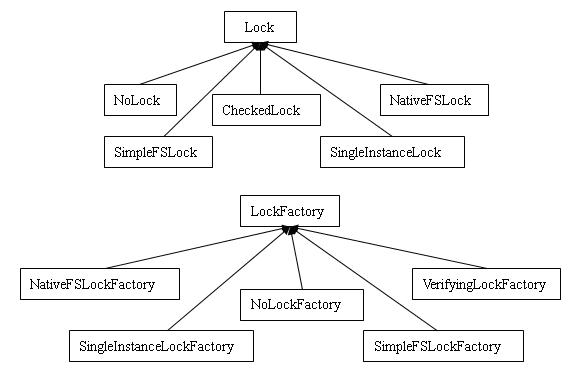Lock/LockFactory類系
綜述:Lucene 用“鎖”的機(jī)制來實(shí)現(xiàn)同一文件夾的互斥訪問:當(dāng)有進(jìn)程訪問需要互斥訪問的文件夾時(shí),首先查看與之關(guān)聯(lián)的“鎖”是否存在,若存在則拒絕訪問;若不存在,則先上“鎖”,訪問之,最后解 “鎖”。不同的Lock子類,具體的“鎖”實(shí)現(xiàn)方式并不一樣。
1.Lock/LockFactory類系的層次圖

2.部分代碼說明
Lock類
Lock本身是一個(gè)抽象類,它提供了4個(gè)方法,但它僅實(shí)現(xiàn)了obtain(long)這一個(gè)方法,其他三個(gè)留給了它的子類去完成。4個(gè)方法的聲明羅列如下:
 public abstract Boolean obtain() throws IOException;
public abstract Boolean obtain() throws IOException;
 public boolean obtain(long lockWaitTimeout) throws LockObtainFailedException;;
public boolean obtain(long lockWaitTimeout) throws LockObtainFailedException;;
 public abstract void release() throws IOException;
public abstract void release() throws IOException;
 public abstract Boolean isLocked();
public abstract Boolean isLocked();
Lock還提供了兩個(gè)靜態(tài)變量:long LOCK_POLL_INTERVAL(默認(rèn)值為1000ms)和final long LOCK_OBTAIN_WAIT_FOREVER(值為-1) ,前者為試圖獲取“鎖”時(shí)的時(shí)間間隔值,后者為當(dāng)lockWaitTimeout設(shè)置為該值時(shí),obtain(long)將會(huì)無限期試圖獲取“鎖”。
obtain(long)的功能為在給定的lockWaitTimeout時(shí)間內(nèi)試圖獲取“鎖”,一旦獲取到,則返回;超過時(shí)間則會(huì)拋出異常。其代碼及注釋如下:
1 public boolean obtain(long lockWaitTimeout)
public boolean obtain(long lockWaitTimeout)
2
 throws LockObtainFailedException, IOException
throws LockObtainFailedException, IOException  {
{
3 failureReason = null;
failureReason = null;
4 // locked試圖獲取“鎖文件”。obtain()的功能是及時(shí)返回是否能取得“鎖文件”
// locked試圖獲取“鎖文件”。obtain()的功能是及時(shí)返回是否能取得“鎖文件”
5 boolean locked = obtain();
boolean locked = obtain();
6 // 給定參數(shù)值為負(fù)并且不等于-1,則拋出參數(shù)值設(shè)置異常
// 給定參數(shù)值為負(fù)并且不等于-1,則拋出參數(shù)值設(shè)置異常
7 if (lockWaitTimeout < 0 && lockWaitTimeout != LOCK_OBTAIN_WAIT_FOREVER)
if (lockWaitTimeout < 0 && lockWaitTimeout != LOCK_OBTAIN_WAIT_FOREVER)
8 throw new IllegalArgumentException(
throw new IllegalArgumentException(
9 "lockWaitTimeout should be LOCK_OBTAIN_WAIT_FOREVER or a non-negative number (got "
"lockWaitTimeout should be LOCK_OBTAIN_WAIT_FOREVER or a non-negative number (got "
10 + lockWaitTimeout + ")");
+ lockWaitTimeout + ")");
11 // 設(shè)置最大睡眠次數(shù)
// 設(shè)置最大睡眠次數(shù)
12 long maxSleepCount = lockWaitTimeout / LOCK_POLL_INTERVAL;
long maxSleepCount = lockWaitTimeout / LOCK_POLL_INTERVAL;
13 long sleepCount = 0; // 睡眠次數(shù)累加器
long sleepCount = 0; // 睡眠次數(shù)累加器
14 // 循環(huán)直到取得“鎖文件”;或者時(shí)間到,則拋出異常
// 循環(huán)直到取得“鎖文件”;或者時(shí)間到,則拋出異常
15
 while (!locked)
while (!locked)  {
{
16 if (lockWaitTimeout != LOCK_OBTAIN_WAIT_FOREVER
if (lockWaitTimeout != LOCK_OBTAIN_WAIT_FOREVER
17
 && sleepCount++ >= maxSleepCount)
&& sleepCount++ >= maxSleepCount)  { // 參數(shù)lockWaitTimeout不為-1且累計(jì)睡眠次數(shù)大于maxSleepCount,拋出異常
{ // 參數(shù)lockWaitTimeout不為-1且累計(jì)睡眠次數(shù)大于maxSleepCount,拋出異常
18 String reason = "Lock obtain timed out: " + this.toString();
String reason = "Lock obtain timed out: " + this.toString();
19
 if (failureReason != null)
if (failureReason != null)  {
{
20 reason += ": " + failureReason;
reason += ": " + failureReason;
21 }
}
22 LockObtainFailedException e = new LockObtainFailedException(
LockObtainFailedException e = new LockObtainFailedException(
23 reason);
reason);
24
 if (failureReason != null)
if (failureReason != null)  {
{
25 e.initCause(failureReason);
e.initCause(failureReason);
26 }
}
27 throw e;
throw e;
28 }
}
29
 try
try  {
{
30 // 睡眠LOCK_POLL_INTERVAL(默認(rèn)1000ms)時(shí)間
// 睡眠LOCK_POLL_INTERVAL(默認(rèn)1000ms)時(shí)間
31 Thread.sleep(LOCK_POLL_INTERVAL);
Thread.sleep(LOCK_POLL_INTERVAL);
32
 } catch (InterruptedException e)
} catch (InterruptedException e)  {
{
33 throw new IOException(e.toString());
throw new IOException(e.toString());
34 }
}
35 // 再次試圖獲取“鎖文件”
// 再次試圖獲取“鎖文件”
36 locked = obtain();
locked = obtain();
37 }
}
38 // 正常退出,
// 正常退出,
39 return locked;
return locked;
40 }
}
SimpleFSLock類
在SimpleFSLock類中,“鎖”是通過給需要訪問的文件夾另外建立一個(gè)文件的方式來實(shí)現(xiàn)的;查看某文件夾是否被上鎖,你需要做的僅僅是查看下與其相關(guān)的“鎖文件”是否存在;解鎖時(shí)只需刪除“鎖文件”就萬事OK了。下面是obtain()方法的代碼及注釋:
1
 public boolean obtain() throws IOException
public boolean obtain() throws IOException  {
{
2
3 // Ensure that lockDir exists and is a directory:
// Ensure that lockDir exists and is a directory:
4 // 確保lockDir存在并且是文件夾類型
// 確保lockDir存在并且是文件夾類型
5
 if (!lockDir.exists())
if (!lockDir.exists())  {
{
6 if (!lockDir.mkdirs()) // 如果lockDir不存在,則試圖為其建立新文件夾,建立失敗則拋出異常
if (!lockDir.mkdirs()) // 如果lockDir不存在,則試圖為其建立新文件夾,建立失敗則拋出異常
7 throw new IOException("Cannot create directory: "
throw new IOException("Cannot create directory: "
8 + lockDir.getAbsolutePath());
+ lockDir.getAbsolutePath());
9
 } else if (!lockDir.isDirectory())
} else if (!lockDir.isDirectory())  {
{
10 // 如果lockDir存在,但不是文件夾,拋出異常
// 如果lockDir存在,但不是文件夾,拋出異常
11 throw new IOException(
throw new IOException(
12 "Found regular file where directory expected: "
"Found regular file where directory expected: "
13 + lockDir.getAbsolutePath());
+ lockDir.getAbsolutePath());
14 }
}
15 // createNewFile成功,返回true; 失敗,false;
// createNewFile成功,返回true; 失敗,false;
16 // 說明:建立成功,也就是說“鎖文件”不存在; 失敗,說明“鎖文件”已經(jīng)存在,也就是說該文件夾已被上鎖
// 說明:建立成功,也就是說“鎖文件”不存在; 失敗,說明“鎖文件”已經(jīng)存在,也就是說該文件夾已被上鎖
17 return lockFile.createNewFile();
return lockFile.createNewFile();
18 }
}
NativeFSLock類
NativeFSLock與SimpleFSLock有些不同,它的“鎖”用的是“鎖文件”的鎖,說起來很是繞口,其實(shí)它只是給“鎖文件”上一把鎖:在查看某文件夾是否能被訪問時(shí),首先檢查與此文件夾關(guān)聯(lián)的“鎖文件”的鎖是否被占用,而不像SimpleFSLock僅僅查看與之相連的“鎖文件”是否存在。正因?yàn)槿绱耍鉀Q了如果JVM異常退出時(shí)遺留的“鎖文件”的問題:在SimpleFSLock中,只要“鎖文件”存在,就被人為該文件夾被鎖,而不能被任何其他進(jìn)程訪問。
NativeFSLock額外定義了一個(gè)私有靜態(tài)變量:private static HashSet LOCK_HELD。它用來記錄“鎖文件”的標(biāo)準(zhǔn)路徑名(canonical path),當(dāng)某文件夾的“鎖文件”標(biāo)準(zhǔn)路徑名存在于LOCK_HELD中,且沒有被上鎖,就說明該文件夾可被訪問;否則拒絕訪問。在解鎖時(shí),需要從LOCK_HELD中刪除“鎖文件”的標(biāo)準(zhǔn)路徑名,刪除“鎖文件”。
NativeFSLock的代碼中包含了很多對(duì)于異常的處理,使得程序看起來很是費(fèi)解。
obtain()的主要代碼及注釋如下:
1
 public synchronized boolean obtain() throws IOException
public synchronized boolean obtain() throws IOException  { // 該方法被設(shè)置為同步訪問
{ // 該方法被設(shè)置為同步訪問
2 // isLocked()為true說明“鎖文件”已被上鎖,正在被使用中
// isLocked()為true說明“鎖文件”已被上鎖,正在被使用中
3
 if (isLocked())
if (isLocked())  {
{
4 // Our instance is already locked:
// Our instance is already locked:
5 return false;
return false;
6 }
}
7
8 // Ensure that lockDir exists and is a directory.
// Ensure that lockDir exists and is a directory.
9
 if (!lockDir.exists())
if (!lockDir.exists())  {
{
10 if (!lockDir.mkdirs())
if (!lockDir.mkdirs())
11 throw new IOException("Cannot create directory: "
throw new IOException("Cannot create directory: "
12 + lockDir.getAbsolutePath());
+ lockDir.getAbsolutePath());
13
 } else if (!lockDir.isDirectory())
} else if (!lockDir.isDirectory())  {
{
14 throw new IOException(
throw new IOException(
15 "Found regular file where directory expected: "
"Found regular file where directory expected: "
16 + lockDir.getAbsolutePath());
+ lockDir.getAbsolutePath());
17 }
}
18
19 String canonicalPath = path.getCanonicalPath();
String canonicalPath = path.getCanonicalPath();
20
21 boolean markedHeld = false; //標(biāo)記在LOCK_HELD中是否存在某“鎖文件”的路徑名
boolean markedHeld = false; //標(biāo)記在LOCK_HELD中是否存在某“鎖文件”的路徑名
22
23
 try
try  {
{
24
25 // Make sure nobody else in-process has this lock held
// Make sure nobody else in-process has this lock held
26 // already, and, mark it held if not:
// already, and, mark it held if not:
27
28
 synchronized (LOCK_HELD)
synchronized (LOCK_HELD)  { // 設(shè)置LOCK_HELD的同步訪問
{ // 設(shè)置LOCK_HELD的同步訪問
29
 if (LOCK_HELD.contains(canonicalPath))
if (LOCK_HELD.contains(canonicalPath))  { // 如果標(biāo)準(zhǔn)路徑存在于LOCK_HELD中,說明該文件被上鎖或正在被上鎖,返回false
{ // 如果標(biāo)準(zhǔn)路徑存在于LOCK_HELD中,說明該文件被上鎖或正在被上鎖,返回false
30 // Someone else in this JVM already has the lock:
// Someone else in this JVM already has the lock:
31 return false;
return false;
32
 } else
} else  {
{
33 // This "reserves" the fact that we are the one
// This "reserves" the fact that we are the one
34 // thread trying to obtain this lock, so we own
// thread trying to obtain this lock, so we own
35 // the only instance of a channel against this
// the only instance of a channel against this
36 // file:
// file:
37 LOCK_HELD.add(canonicalPath); // 添加路徑名到LOCK_HELD中
LOCK_HELD.add(canonicalPath); // 添加路徑名到LOCK_HELD中
38 markedHeld = true; // 設(shè)置為true
markedHeld = true; // 設(shè)置為true
39 }
}
40 }
}
41
42
 try
try  {
{
43 // 建立“鎖文件”
// 建立“鎖文件”
44 f = new RandomAccessFile(path, "rw");
f = new RandomAccessFile(path, "rw");
45
 } catch (IOException e)
} catch (IOException e)  {
{
46 // On Windows, we can get intermittant "Access
// On Windows, we can get intermittant "Access
47 // Denied" here. So, we treat this as failure to
// Denied" here. So, we treat this as failure to
48 // acquire the lock, but, store the reason in case
// acquire the lock, but, store the reason in case
49 // there is in fact a real error case.
// there is in fact a real error case.
50 failureReason = e;
failureReason = e;
51 f = null; // 建立失敗,則f= null
f = null; // 建立失敗,則f= null
52 }
}
53
54
 if (f != null)
if (f != null)  {
{
55
 try
try  {
{
56 // 獲取“鎖文件”的通道
// 獲取“鎖文件”的通道
57 channel = f.getChannel();
channel = f.getChannel();
58
 try
try  {
{
59 // 給“鎖文件”上鎖
// 給“鎖文件”上鎖
60 lock = channel.tryLock();
lock = channel.tryLock();
61
 } catch (IOException e)
} catch (IOException e)  {
{
62 // At least on OS X, we will sometimes get an
// At least on OS X, we will sometimes get an
63 // intermittant "Permission Denied" IOException,
// intermittant "Permission Denied" IOException,
64 // which seems to simply mean "you failed to get
// which seems to simply mean "you failed to get
65 // the lock". But other IOExceptions could be
// the lock". But other IOExceptions could be
66 // "permanent" (eg, locking is not supported via
// "permanent" (eg, locking is not supported via
67 // the filesystem). So, we record the failure
// the filesystem). So, we record the failure
68 // reason here; the timeout obtain (usually the
// reason here; the timeout obtain (usually the
69 // one calling us) will use this as "root cause"
// one calling us) will use this as "root cause"
70 // if it fails to get the lock.
// if it fails to get the lock.
71 failureReason = e;
failureReason = e;
72
 } finally
} finally  {
{
73
 if (lock == null)
if (lock == null)  { // 如果沒有取得鎖,需關(guān)閉通道并設(shè)置其為null
{ // 如果沒有取得鎖,需關(guān)閉通道并設(shè)置其為null
74
 try
try  {
{
75 channel.close(); //關(guān)閉通道
channel.close(); //關(guān)閉通道
76
 } finally
} finally  {
{
77 channel = null; //設(shè)置為null
channel = null; //設(shè)置為null
78 }
}
79 }
}
80 }
}
81
 } finally
} finally  {
{
82
 if (channel == null)
if (channel == null)  { // 如果通道獲取失敗或者上鎖異常,關(guān)閉“鎖文件”
{ // 如果通道獲取失敗或者上鎖異常,關(guān)閉“鎖文件”
83
 try
try  {
{
84 f.close(); // 關(guān)閉“鎖文件”
f.close(); // 關(guān)閉“鎖文件”
85
 } finally
} finally  {
{
86 f = null;
f = null;
87 }
}
88 }
}
89 }
}
90 }
}
91
92
 } finally
} finally  {
{
93 // markedHeld為ture,但isLocked()為false,說明上鎖途中出現(xiàn)異常
// markedHeld為ture,但isLocked()為false,說明上鎖途中出現(xiàn)異常
94 // 需刪除“鎖文件”的路徑名
// 需刪除“鎖文件”的路徑名
95
 if (markedHeld && !isLocked())
if (markedHeld && !isLocked())  {
{
96
 synchronized (LOCK_HELD)
synchronized (LOCK_HELD)  { // 注意同步訪問LOCK_HELD
{ // 注意同步訪問LOCK_HELD
97
 if (LOCK_HELD.contains(canonicalPath))
if (LOCK_HELD.contains(canonicalPath))  {
{
98 LOCK_HELD.remove(canonicalPath);
LOCK_HELD.remove(canonicalPath);
99 }
}
100 }
}
101 }
}
102 }
}
103 // 經(jīng)過以上過程,若成功上鎖則isLock()為true;反之,false
// 經(jīng)過以上過程,若成功上鎖則isLock()為true;反之,false
104 return isLocked();
return isLocked();
105 }
}